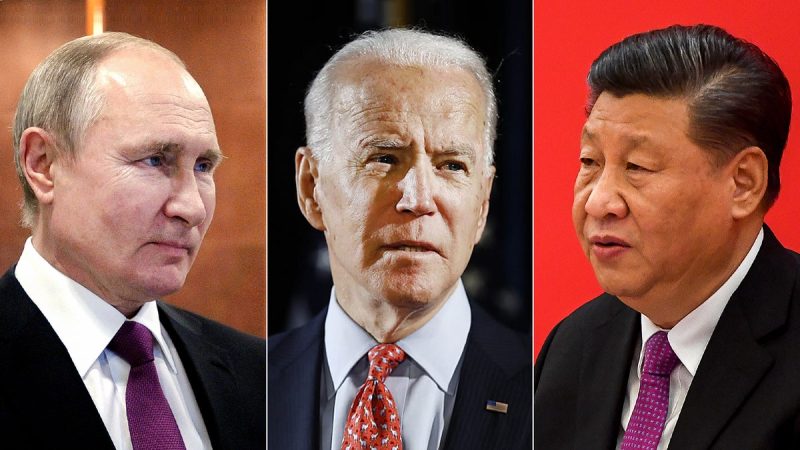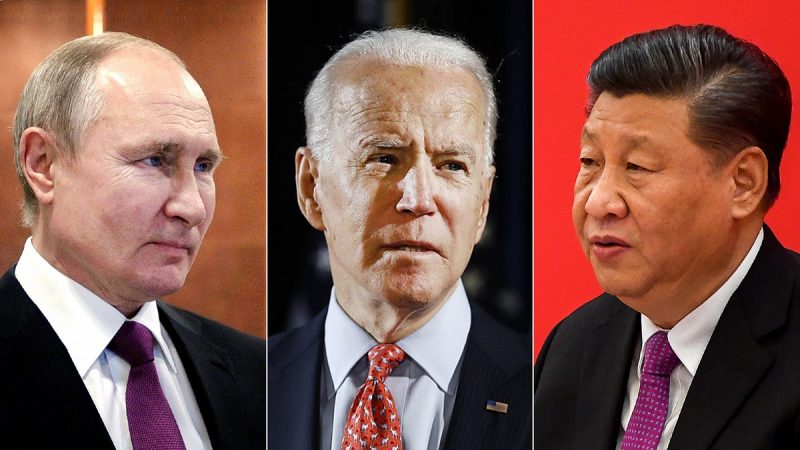
As we still digest how in the world a random 20-year-old, armed with a high-powered rifle, could have walked up within 150 yards of a presidential campaign rally, climbed onto a rooftop, in full view of Secret Service snipers, set up and fired multiple rounds, nearly assassinating a former U.S. president. And while the shooter, ostensibly, was acting completely alone, no one among the dozens of law enforcement and security personnel interdicted him.
You know who else has been watching closely this nearly catastrophic event, as well as everything else that is happening in our country? China and Russia, both of whom consider the United States as their top adversary that must be defeated – if not on the battlefield then from within.
Vladimir Putin, Xi Jinping and their respective spy agencies have been evaluating the recent events taking place in America – the Trump-Biden debate, the Washington NATO summit, and President Biden’s fitness for another term.
They have concluded that despite the rhetoric and chest-beating coming out of Washington, America’s security is compromised. It would be surprising if the two dictators refrained from exploiting this. Here’s why.
First, between now and Jan. 20, the U.S. will continue to be led by a president who is seen as increasingly unable to fully discharge his duties as commander in chief, a critical vulnerability, especially in a time of crisis or even a war. The Trump-Biden presidential debate and the ‘Big Boy’ presser, during which Biden called Ukraine’s Volodymyr Zelenskyy ‘President Putin’ and Kamala Harris ‘Vice President Trump,’ confirmed what Putin and Xi, already knew – Biden is severely impaired, cognitively and physically.
While many Americans may have been unaware of this fact, due to concerted efforts by Biden’s handlers and some in the media to conceal it, it was not a surprise to the Russians and Chinese whose intelligence services routinely develop profiles of every U.S. president. The new takeaway for Putin and Xi is that, bombarded with calls for Biden to withdraw from the race, his administration is now fighting for its survival and clearly isn’t focused on U.S. security. It won’t take much to further unbalance an already distracted U.S. president and his team.
Second, by committing itself more deeply to Ukraine’s security, the United States is further entangling itself into a probable war with Russia, which would be catastrophic. The Pentagon has no viable military strategy to win such a war – just like to this day, it has none in Ukraine. Such a war will likely cross the nuclear threshold, as assessed by U.S. intelligence.
During the Washington summit, the 32-member NATO alliance formally declared Ukraine, which has served as part of Russia’s strategic security perimeter since the ninth century, on an ‘irreversible’ path to membership. Russia and the United States have declared each other, formally, as top threats to their respective security.
Putin, who for years has stated that a NATO membership for Ukraine is a ‘red line,’ will likely risk going to war with the United States over Ukraine, as revealed by multiple war games conducted by the U.S. intelligence community. On his orders, a war-fighting strategy, which includes nuclear arms, space weapons and cyber warfare, was developed. The Kremlin believes this strategy can achieve victory on Russia’s terms.
Third, neither the United States, nor NATO has the industrial capacity to prosecute a war with Russia, let alone a two-front war, simultaneously with Russia and China.
Putin has prepared for a protracted years-long war in Ukraine, having transitioned the Russian military and economy onto a wartime footing seven years prior to the invasion. Putin has also sanction-proofed Russia’s economy, which – contrary to Washington’s forecasts – has been growing, propelled by the weapons manufacturing sector. Having a comfortable financial cushion of $580 billion in foreign currency and gold reserves, Russia has increased its defense budget by 70% in2024 compared to 2023.
Russia’s weapons production capacity has increased in one year as follows: sevenfold for battle tanks, sixfold for ammunition, quadrupled for armored platforms, and doubled for artillery and rocket systems. Drone production increased by 80% in 2023.
In contrast, the U.S. and European allies, which officially are not at war, lack production and contractual capacity to match Putin’s war machine. Last week, NATO Secretary-General Jens Stoltenberg admitted during an event at the U.S. Chamber of Commerce that the West’s production capacity has been delinquent and that Ukraine’s demands for military hardware in order to stay in the fight against Russia are not fully met.
Unlike Russia, where Putin personally can order factories to transition from civilian to military production, the U.S. and European defense industries are subject to bureaucratic requirements, such as funding approvals and contracting capacity. These companies cannot start building weapons until a contract is negotiated, approved and funded.
Besides, a lot of U.S. high-tech weaponry has proven ineffective on the battlefield in Ukraine. The Russians, who have studied U.S. employment of technology in military operations for the past two decades, have been developing countermeasures for what the Pentagon calls ‘network centric warfare.’ Russia’s superior electronic warfare capabilities have disrupted or degraded many U.S. combat systems reliant on GPS.
According to the Wall Street Journal, citing Ukrainian commanders, certain U.S. munitions are no longer in use on the battlefield. For example, the M982 Excalibur, developed by RTX and BAE Systems, and the ground-launched small diameter bomb, manufactured by Boeing and Sweden’s Saab.
In April, a top leader in the U.S. Space Force, a new branch of service stood up by President Trump, noted the ‘unprecedented level of electronic warfare (EW)’ used by Russia, to jam U.S. GPS, on which the U.S. military relies for basic functions, including precision targeting and command and control. Col. Nicole Petrucci, the commander of the USSF’s combat-ready forces as head of Space Delta 3, during an AFA Warfighters in Action event, expressed concern that U.S. forces would struggle operating in such an environment. She noted the need for ‘the right simulators’ and ‘good enough’ instructors who understand the ‘high-end threat environment,’ to train U.S. military personnel to fight in wars with top U.S. opponents such as Russia and China.
Other U.S. officials have admitted that the high level of electronic warfare in Ukraine could dwarf what the U.S. could face in a conflict with China, which plans to cripple U.S. satellites in wartime, including kinetically.
In his Big Boy press conference, Biden claimed that ‘NATO stands stronger than it has ever been.’ He reminded us that America’s obligation of Article 5 – which commits the United States to defending any NATO member if attacked – is ‘sacred.’ He added that he ‘will not walk away from Ukraine,’ which has yet to become a NATO member.
What Putin and Xi have concluded, however, is that despite billions of dollars spent annually on intelligence, high-tech weaponry and foreign wars, Washington has not closed some glaring gaps in America’s security. The world’s most brutal dictators are delighted to know that a former and possibly future U.S. president is still alive only thanks to an act of God, and not because he is well-protected.
